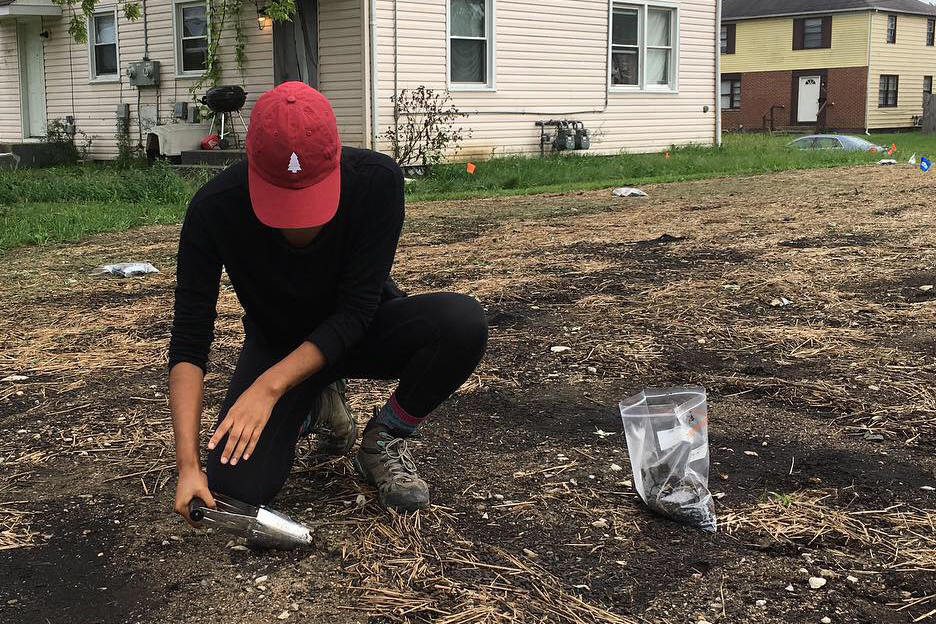Ohio's high soil arsenic levels due to natural processes
April 25, 2014 - Staff
Geologic and soil processes are to blame for significant baseline levels of arsenic in soil throughout Ohio, according to a study published in the May-June 2014 issue of the Journal of Environmental Quality.
The analysis of 842 soil samples from all corners of Ohio showed that every single sample had concentrations higher than the screening level of concern recommended by the U.S. Environmental Protection Agency. The findings shouldn’t alarm the public, say the authors, who note that regulatory levels are typically set far below those thought to be harmful. Rather, the findings pose a real challenge for regulators, who must determine what levels should trigger action when natural arsenic levels everywhere are above suggested screening standards.
The researchers found that the patterns of arsenic in Ohio soils are most closely related to the arsenic content of the underlying bedrock, which was formed approximately 250 to 300 million years ago. Glacial and soil processes have modified the landscape since.
“The distribution of arsenic throughout Ohio appears to be the result of natural patterns,” says first author Erik Venteris of the Department of Energy’s Pacific Northwest National Laboratory (PNNL). Venteris was with the Division of Geological Survey of the Ohio Department of Natural Resources when the study was done.
 Researchers from PNNL, Ohio State University, and Ohio’s Division of Geological Survey did the study, one of the most thorough analyses of arsenic levels to date over a broad area.
Researchers from PNNL, Ohio State University, and Ohio’s Division of Geological Survey did the study, one of the most thorough analyses of arsenic levels to date over a broad area.
Scientists have long known that soil arsenic levels in Ohio and many other parts of the world are consistently high, even beyond spikes due to smelting, herbicide use, and other human activity. People can be exposed to soil arsenic in a number of ways: through drinking water, the foods they eat, and even the minute amounts of dirt they unknowingly ingest each day.
High levels of arsenic cause cancer, neuromuscular damage, skin diseases, and death. But like many other compounds that are naturally abundant in the Earth’s crust, arsenic does little or no measurable harm at very low levels.
The problem is that deciding just what arsenic levels are harmful, and when regulators should take action to lower them, is tremendously difficult.
To get a comprehensive picture of arsenic levels across the state, the team analyzed two soil samples each from 348 sites throughout Ohio (one sample from a depth of 6-12 inches and another from 12-24 inches) and 144 sediment samples from streams. The samples included ones previously collected by the U.S. Geological Survey as part of the National Geochemical Survey, and from an earlier study related to uranium exploration.
Because the scientists wanted to know the baseline arsenic levels, they focused on samples from areas in Ohio with minimal human activity. For example, arsenic has been used for decades as a wood preservative and in pesticides and herbicides, so soil samples near fence posts and orchards were avoided.
Findings
Overall, arsenic in the samples ranged from 2 to 45.6 parts per million (ppm) by weight, with an average of 9.69 ppm. For comparison, the U.S. EPA’s screening standard of concern is 0.39 ppm. Very few samples had less arsenic than 3 ppm; samples more than 10 ppm were very common; and levels of more than 20 ppm were common for central Ohio.
“When every soil sample has more arsenic than the recommended screening level, it may be time to re-evaluate those regulatory levels and think about how best to interpret the data,” says co-author Nicholas Basta, a professor of Soil and Environmental Chemistry at Ohio State.
The study also suggested that bedrock created 250 to 425 million years ago—a time when Ohio was positioned near the equator and frequently covered by warm, tropical seas—is the source of the arsenic. Soils in some areas had consistently higher levels, including central, western and northeastern Ohio. Others, such as northwestern and southwestern Ohio, had lower levels.
The reason for these differences, the authors say, is that as rocks weathered over time to create soil, they released arsenic that became part of the soil. In the meantime, the scientists believe other conditions, such as consistently wet soils, reduced arsenic levels in certain regions, such as northwest Ohio.
“Many processes can break down bedrock, spread the material, and potentially mobilize the arsenic so it leaches out,” Venteris says. “How much arsenic is present in a given location depends on what was originally in the bedrock and how that rock has been altered over time through complex erosion and chemical weathering processes. The result is that arsenic levels vary significantly—but predictably—within a region.”
Basta says the findings could help regulators weigh risks and remediation efforts involving arsenic. That’s frequently a concern when builders create new homes or other structures.
“These findings should be helpful to help evaluate risks properly,” says Basta, an expert on rehabilitating urban soils. “Now we have a good scientific understanding of how the levels throughout Ohio came to be.”
